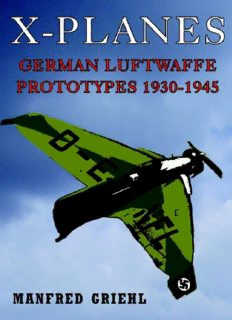
X-PLANES: German Luftwaffe Prototypes 1930-1945 PDF
Preview X-PLANES: German Luftwaffe Prototypes 1930-1945
First published in 2012 by Frontline Books, an imprint of Pen & Sword Books Ltd., 47 Church Street, Barnsley, S. Yorkshire, S70 2AS. Visit us at www.frontline-books.com, email [email protected] or write to us at the above address. Copyright © 2012 by Manfred Griehl The right of Manfred Griehl to be identified as the author of this work has been asserted by him in accordance with the Copyrights, Designs and Patents Act 1988. 9781783034192 No part of this publication may be reproduced, stored in or introduced into a retrieval system, or transmitted, in any form, or by any means (electronic, mechanical, photocopying, recording or otherwise) without the prior written permission of the publisher. Any person who does any unauthorized act in relation to this publication may be liable to criminal prosecution and civil claims for damages. CIP data records for this title are available from the British Library. Printed and bound in Great Britain by MPG Typeset in ITC Garamond and Frutiger by Donald Sommerville, TA15 6XN Table of Contents Title Page Copyright Page 1 - Preface and Acknowledgements 2 - Aircraft Development by the RWM and RLM 3 - Germany’s Test Centres 4 - Experimental, Test and Trials Units 5 - Test Detachments and Squadrons 6 - General Aviation Research 7 - Development Projects in 1945 8 - Aircraft Prototypes 1 Preface and Acknowledgements The development of civil and military aircraft in Germany between the years 1930 and 1945 was an impressive portent of things to come in the world of aviation. The introduction and use of ever more highly advanced technology by both the German aircraft industry and governmental research establishments throughout the country led to huge strides forward in production and design. Thanks to new construction techniques, the various manufacturers were in a position to offer a whole host of modern, state-of-the-art aircraft and helicopters. But very few of these projects were destined ever to be produced. The vast majority of the outstanding, not to say revolutionary designs submitted to the Reichsluftfahrtministerium (RLM: Reich Ministry of Aviation) were rejected by those in authority. The diehards who inhabited the corridors of power in Berlin were still blinkered by the criteria of World War I. In their minds all that was required to ensure German air superiority were aircraft that were just a few miles per hour faster than their British, French or Russian counterparts. Ultimately it was the RLM, together with other state agencies – not least Albert Speer’s omnipotent Reichsministerium für Rüstung und Kriegsproduktion (Reich Ministry of Armaments and War Production) and Heinrich Himmler’s all- embracing SS-Wirtschafts-hauptamt (SS Central Office of Economics) – which were to assume control over the development and production of all new Luftwaffe aircraft. For, as Hermann Göring’s Luftwaffe lost one campaign after the other, its fortunes went into terminal decline. Its authority was taken over by the administrative departments of the RLM and the SS until, in the end, Germany’s aircraft manufacturers were stripped of all freedom of choice. Before going into the details of aircraft development and describing all the important German designs of the 1930 – 1945 period – civil and military, fixed- wing and rotary – I would like to take this opportunity to thank all those who have helped me in my work by supplying many of the photographs and much invaluable data and information: Mrs Peter Achs, Gebhard Aders, Claus Backmann, Michael Balss, Heinz Birkholz, Paul E. Bezouska, Heinz Borgmann, Heinz Borzutzki, Rick Chapman, Peter W. Cohausz, Eddie Creek, James C. Crow, Hans-Peter Dabrowski, Andreas Duda, Manfred Franzke, Hans Grimm, Hans Handig, Martin Handig, Peter Heck, Dieter Herwig, Hans-Jochen Keilholz, Karl-Heinz Kens, Dr Volker Koos, Dr Armin Kranzhoff, Dipl.-Ing. Karl Kössler, Werner Kossin, Manfred Krieg, Gerhard Lang, Bruno Lange, Manfred Leihse, Werner Lerche, Dipl.-Ing. Horst Lommel, Richard P. Lutz, Dr-Ing. Heinz Mankau, Hans-Justus Meier, Josef Müller, Frederic Müller- Romminger, Prof. Dr Sönke Neitzel, Heinz J. Nowarra, Dr Alfred Price, Willy Radinger, Stephen Ransom, Christoph Regel, Philippe Ricco, Heinz Riedinger, Ricco, Hans Ring, Ulrich Rohrbach, Simon Schatz, Hanfried Schliephake, Leo Schmidt, Helmut Schubert, Günter Sengfelder, Franz Selinger, Hans-Heiri Stapfer, Mag. Helmut Stubner, Harald Thiele, Oliver Thiele, Fritz Trenkle, Udo Trümper, Manfred Urschel, Bernd Vetter, Christoph Vernaleken, Gerhard Wachtl, Helmuth F. Walther, John Weal, Eberhardt D. Weber, Hans Willbold and Dipl.-Ing. Zucker. Furthermore I would like to thank the following institutions and firms for their assistance: Airbus Deutschland, Blohm & Voss, Deutscher Aeroclub, Deutsche Gesellschaft für Luft-und Raumfahrt Lilienthal-Obert, Dornier GmbH, EADS, Flughafen AG Frankfurt/ Main, Heinkel GmbH, Hubschrauber Museum Bückeburg, IHK Köln, MBB, MTU, USAF. I should perhaps point out that a number of the official sources from the years 1930 – 1945 I have used for reference purposes contain conflicting information as to the actual serial numbers and/or codes carried by certain aircraft. Likewise, some pilot’s logbooks may quote different numbers or codes for a particular machine. If any reader possesses reliable and verifiable information on the subject, I would welcome it with a view to correcting any mistakes inadvertently made. Manfred Griehl, Mainz, 2012 [email protected] 2 Aircraft Development by the RWM and RLM After its defeat in World War I the former German Reich was forced to carry out the development and evaluation of its future civil and military aircraft under conditions of the strictest secrecy. A number of new designs, particularly warplanes, were tested by German pilots and crews at bases in Italy, Sweden and the Soviet Union. Once the Allies had lifted their ban on the production of civil machines in Germany, several military types were developed under the guise of commercial airliners or civil courier aircraft. Until 1933 everything relating to civil aviation came under the control of the Weimar government’s Reichsverkehrsministerium (Reich Ministry of Transport), while all military aviation matters were the (clandestine) responsibility of the Reichswehrministerium (RWM: Reich Ministry of Defence).
Description: